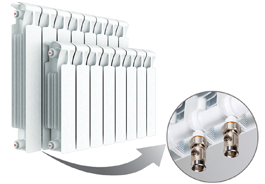1. Which are the CRITERIA?
Can you by way of example wish to fit Edwardian-type cast-iron radiators? Or do you want to fit radiators at the cheapest possible cost? Or do the radiators have to comply with some sort of design need – including being flush together with the floor?
2. POSITIONING
Back in the day considered best practice to put radiators below windows, given that they were deemed to get cold spots. However, in case your property is double-glazed, the radiators might be positioned to match design and space needs since the areas all around the windows will likely be almost as warm as the other walls inside your home.
3. WINDOWS
Keep clear about placing radiators opposite a window – there exists a possibility that they may draw cold air from your window and hang up up a chilly airflow that cuts across the room. If possible, attempt to position the radiators at right angles for the window on one of the side walls.
4. SIZE & NUMBER
The introduction of double-panel and finned radiators signifies that you’ll be able to reduce the size and variety of radiators inside a room towards the minimum. This is a good option if your room is long and narrow.

5. CALCULATIONS
To a large degree, the telephone number and kind of radiators relates to the scale and also the space being heated, so calculate the cubic capacity from the rooms you want to heat. Find out the floor area by multiplying the width with the room by its length, and after that multiply this by its height. As an example, for any room 3m wide, 4m long and 2m high, the sum is 3m x 4m = 12sqm x 2m = 24cu m. You simply must heat 24cu m. Work with a Mears wheel to calculate the number of radiators required.
6. UNDERFLOOR HEATING
Underfloor heating is costly to put in, though the water within the system must not be heated on the same high temperatures like with a radiator installation, so running costs are lower.
7. INSTALLING UNDERFLOOR HEATING
Underfloor heating might be positioned in existing houses in numerous different locations – under concrete slabs, or suspended under wooden floors and/or in ceiling spaces.
8. TRENCH HEATERS
These are simply small radiators which can be placed in trenches so that they are flush with all the floor. They are the best place when you have floor-to-ceiling windows, and want to achieve a clean minimal look
9. CONVECTOR HEATERS
Wet central heating convector heaters are an appealing option, and extremely good if you need instant heating. The heaters are made up of several finned pipes, rather as being a larger version of a car radiator. Doing his thing, the cold air passes through the fins, gets hot and rises, using the effect that hot air is released from the the top radiator and cold air enters at the bottom. Some models are fitted with electric fans and dampers that permit you to turn the heatup or into meet your requirements.
10. SKIRTING RADIATORS
These are the best place if you want to achieve a level, all-round background heat inside a room that’s also heated by a fire. Skirting radiators are all around in kit form.
For more details about zamena batarey v kvartire please visit site: click for more.
